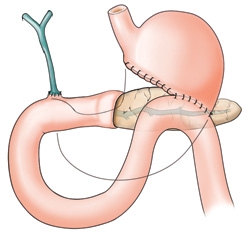Guide to Whipple Procedure (Pancreaticoduodenectomy)
Reviewed by the physicians of Columbia’s Pancreatic Surgery Team, October 2024
 Pancreaticoduodenectomy, often referred to as the Whipple procedure, is the most common operation to treat pancreatic cancer. The procedure is named after Allen Oldfather Whipple, former chairman of the Department of Surgery at Columbia University who pioneered the procedure. It is used to treat tumors located in the head of the pancreas where approximately 75% of pancreatic cancer tumors occur.
Pancreaticoduodenectomy, often referred to as the Whipple procedure, is the most common operation to treat pancreatic cancer. The procedure is named after Allen Oldfather Whipple, former chairman of the Department of Surgery at Columbia University who pioneered the procedure. It is used to treat tumors located in the head of the pancreas where approximately 75% of pancreatic cancer tumors occur.
There are two common types of Whipple procedures - the conventional Whipple and the pylorus-sparing Whipple. The conventional Whipple involves removal of the head of the pancreas, the duodenum, and a portion of the stomach, as well as the gallbladder and a portion of the bile duct. The remaining stomach, bile duct and pancreas are then reconnected to the digestive tract to restore flow of ingested contents, digestive enzymes and bile. In a pylorus-sparing Whipple, the section of stomach is not removed during the operation.
A Whipple procedure typically requires between 4 and 6 hours depending on the location and pathology of the tumor.
The type of surgery required depends largely on the location of the tumor in your pancreas. Your surgeon will recommend the procedure that removes the tumor and affected tissue while safely preserving as much of the pancreas as possible.
Next Steps
If you or someone you care for is dealing with a pancreatic condition, the Pancreas Center is here for you. Whether you need a diagnosis, treatment, or a second opinion, we have an entire team of experts ready to help.
Call us at (212) 305-9467 or use our online form to get in touch today.
Related Services
Related Topics
- Pancreatic Cancer
- Pancreatic Cysts
- Pancreatitis
- Pancreatectomy
- Chemotherapy for Pancreatic Cancer
- Endoscopic Treatment for Pancreatic Disease
- Non-Invasive Tests for Pancreatic Cancer
- Palliative Procedures
- Surgery for Pancreatic Cancer
- Total Pancreatectomy with Autologous Islet Cell Transplantation
See all Related Topics »
